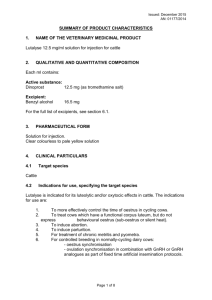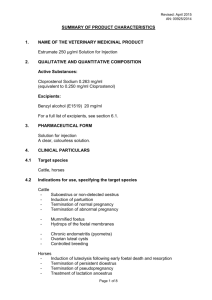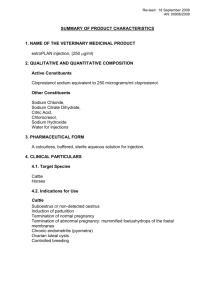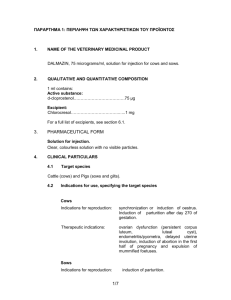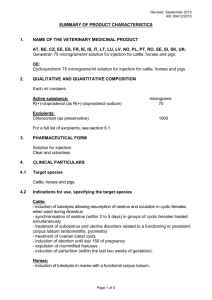Lutalyse - Veterinary Medicines Directorate
advertisement
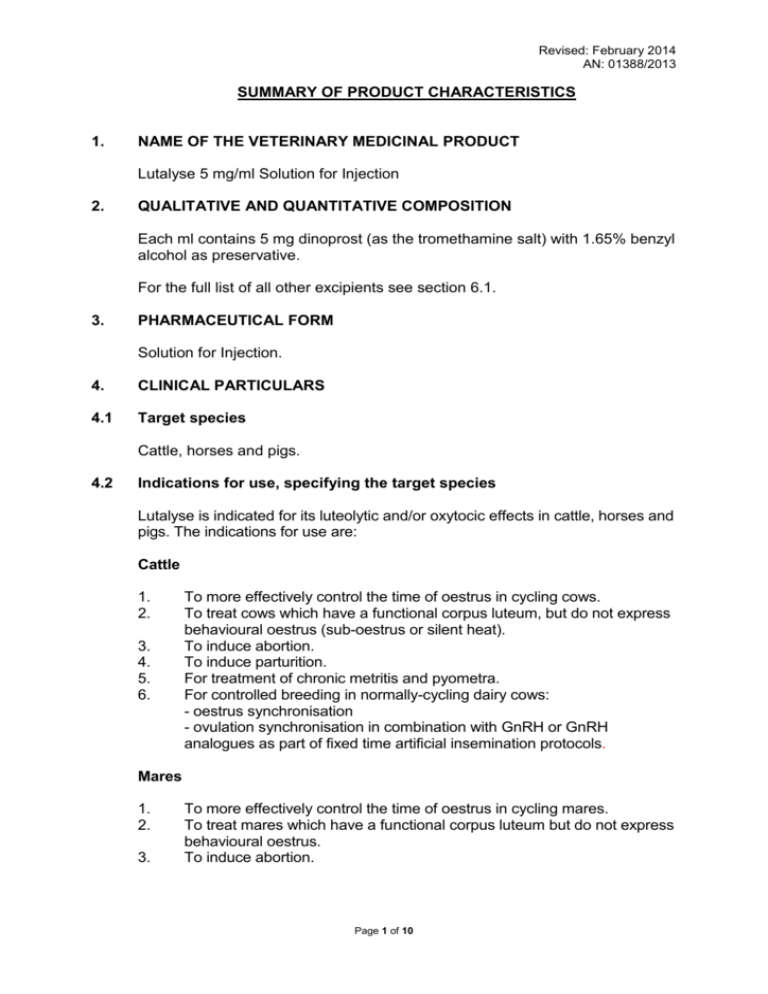
Revised: February 2014 AN: 01388/2013 SUMMARY OF PRODUCT CHARACTERISTICS 1. NAME OF THE VETERINARY MEDICINAL PRODUCT Lutalyse 5 mg/ml Solution for Injection 2. QUALITATIVE AND QUANTITATIVE COMPOSITION Each ml contains 5 mg dinoprost (as the tromethamine salt) with 1.65% benzyl alcohol as preservative. For the full list of all other excipients see section 6.1. 3. PHARMACEUTICAL FORM Solution for Injection. 4. CLINICAL PARTICULARS 4.1 Target species Cattle, horses and pigs. 4.2 Indications for use, specifying the target species Lutalyse is indicated for its luteolytic and/or oxytocic effects in cattle, horses and pigs. The indications for use are: Cattle 1. 2. 3. 4. 5. 6. To more effectively control the time of oestrus in cycling cows. To treat cows which have a functional corpus luteum, but do not express behavioural oestrus (sub-oestrus or silent heat). To induce abortion. To induce parturition. For treatment of chronic metritis and pyometra. For controlled breeding in normally-cycling dairy cows: - oestrus synchronisation - ovulation synchronisation in combination with GnRH or GnRH analogues as part of fixed time artificial insemination protocols. Mares 1. 2. 3. To more effectively control the time of oestrus in cycling mares. To treat mares which have a functional corpus luteum but do not express behavioural oestrus. To induce abortion. Page 1 of 10 Revised: February 2014 AN: 01388/2013 Pigs 1. 2. 4.3 Induction of parturition To reduce the weaning to oestrus interval (WOI) and the weaning to fertile service interval (WFSI) in sows in herds with reproductive problems. Contraindications Contra-indicated in animals suffering from either acute or sub-acute disorders of the vascular system, gastro-intestinal tract or respiratory system. Contraindicated when abortion or parturition is not intended. Do not administer by the intravenous route. 4.4 Special warnings for each target species Cattle: Localized post injection bacterial infections that may become generalized have been reported. Aggressive antibiotic therapy, particularly covering clostridial species, should be employed at the first sign of infection. Careful aseptic techniques should be employed to decrease the possibility of post injection bacterial infections. 4.5 Special precautions for use (i) Special precautions for use in animals 1. 2. 3. 4. 5. 6. Localized post injection bacterial infections that may become generalized have been reported. Aggressive antibiotic therapy, particularly covering clostridial species, should be employed at the first sign of infection. Careful aseptic techniques should be employed to decrease the possibility of post injection bacterial infections. Animals should not be treated if they suffer from either acute or sub-acute disorders of the vascular system, gastro-intestinal tract or respiratory system. Pregnancy status should be determined prior to injection since Lutalyse has been demonstrated to result in abortion or parturition induction when administered at sufficiently high doses to many animal species. Lutalyse is ineffective when administered prior to day five after ovulation. If pregnant, the unlikely possibility of uterine rupture should be borne in mind, especially if cervical dilation does not occur. Induction of parturition in pigs earlier than 72 hours prior to predicted farrowing date may result in reduced piglet viability. Page 2 of 10 Revised: February 2014 AN: 01388/2013 (ii) Special precautions to be taken by the person administering the veterinary medicinal product to animals 1. 2. 3. 4. 5. 4.6 Prostaglandins of the F2 type can be absorbed through the skin and may cause bronchospasm or miscarriage. Care should be taken when handling the product to AVOID SELF-INJECTION or SKIN CONTACT. Women of child-bearing age, asthmatics and persons with bronchial or other respiratory problems should avoid contact with, or wear disposable plastic gloves when administering, the product. Accidental spillage on the skin should be washed off immediately with soap and water. Wash hands after use. Adverse reactions (frequency and seriousness) Cattle The most frequently observed side-effect is increased rectal temperature at a 5x or 10x overdose. However, rectal temperature changes have been transient in all cases observed and have not been detrimental to the animal. Limited salivation has been seen in some instances. Localized post injection bacterial infections that may become generalized have been reported. Aggressive antibiotic therapy, particularly covering clostridial species, should be employed at the first sign of infection. Careful aseptic techniques should be employed to decrease the possibility of post injection bacterial infections. Horses The most frequently observed side-effects are sweating and decreased rectal temperatures. However, these have been transient in all cases observed and have not been detrimental to the animal. Other reactions seen have been increase in heart rate, increase in respiration rate, some abdominal discomfort, locomotor incoordination and lying down. These effects are usually seen within 15 minutes of injection and disappear within one hour. Mares usually continue to eat during the period of expression of side-effects. Pigs Transient side-effects consisting of increased body temperature, increased respiratory rate, increased salivation, stimulation of defaecation and urination, flushing of the skin and restlessness (arching of back, pawing, and rubbing and gnawing the crate) occur occasionally following the administration of dinoprost in pregnant sows and gilts. These effects tend to parallel the signs exhibited by sows prior to normal parturition, only they appear to be condensed in time. These effects are usually seen within 15 minutes of injection and disappear within one hour. Page 3 of 10 Revised: February 2014 AN: 01388/2013 4.7 Use during pregnancy, lactation or lay Termination of pregnancy is an indication for use. 4.8 Interaction with other medicinal products and other forms of interaction None known. 4.9 Amounts to be administered and administration route A single injection of the recommended dose of dinoprost activity is luteolytic provided a functional corpus luteum is present. Administer by intramuscular injection. Full aseptic precautions must be taken. Use a sterile syringe and needle and make the injection through an area of clean dry skin. Care should be taken to avoid injection through wet or dirty areas of skin. Cattle The dose for all indicated uses in cattle is 5 ml Lutalyse (25 mg dinoprost) Mares The dose for all indicated uses in mares is 1 ml Lutalyse (5 mg dinoprost) Pigs Induction of parturition: 2 ml Lutalyse (10 mg dinoprost) within 72 hours of expected parturition. Use post-partum: 2 ml Lutalyse (10 mg dinoprost) 24 to 48 hours after parturition. NOTES 1. Oestrus control in cycling cattle and horses. Individual cows or heifers treated during dioestrus will normally return to oestrus and ovulate within two or four days after treatment. Mares treated during dioestrus will normally return to oestrus within two to four days and ovulate 8 to 10 days after treatment. This may be employed to advantage as an effective aid towards managing oestrus and breeding in individual animals. (Note: Administration of Lutalyse to cattle and horses within four days after oestrus is unlikely to result in luteolysis of the corpus luteum. Administration within 48 hours before onset of the next oestrus may not influence the timing of the oestrus after treatment). Page 4 of 10 Revised: February 2014 AN: 01388/2013 2. Treatment of sub-oestrus (no visible oestrus) in cattle and horses. Individual cattle may have normal cyclical ovarian activity, without detectable behavioural oestrus; this occurs most frequently in the winter months, at peak lactation in high producing dairy cows and in suckler beef cows. If a corpus luteum is present and ovulation has not occurred in the previous four days, administration of Lutalyse will result in corpus luteum regression followed by return to oestrus and ovulation. Breeding of cattle treated with Lutalyse for the above indication may be by natural service, artificial insemination at the usual time in relation to observed oestrus, or by fixed time insemination (78 hours or 72 and 90 hours posttreatment). In extended dioestrus in mares there is failure to exhibit regular oestrus cycles as distinct from true anoestrus. Many mares described as anoestrual during the breeding season have serum progesterone levels consistent with the presence of a functional corpus luteum. A proportion of 'barren', maiden and lactating mares do not exhibit regular oestrus cycles and may be in extended dioestrus. Following abortion, early foetal death and resorption, or as a result of 'pseudo-pregnancy' there may be serum progesterone levels consistent with a functional corpus luteum. Treatment of such mares with Lutalyse usually results in regression of the corpus luteum followed by oestrus and/or ovulation. 3. Induction of abortion in cattle and mares. Lutalyse may be used to terminate pregnancy in cattle and mares through its luteolytic effect during those stages of pregnancy in which the corpus luteum is sensitive to its action and in which maintenance of pregnancy is dependent upon the corpus luteum as the sole source of progesterone. Stage of gestation in cattle is an important factor influencing response. The percentage of animals responding to a single intramuscular injection decreases as the gestation period increases. Approximate percentage responding are 90% within the first 100 days of gestation, 60% within 101-150 days of gestation and 40% in animals beyond 150 days of gestation. In the early stages of gestation, abortion will usually occur within one week, but as gestation length increases, the period to abortion following injection may also increase. In mares up to day 35 of pregnancy luteal regression with Lutalyse will induce abortion; response to treatment between days 40 and 90 of gestation is less predictable, possibly due to PMSG secretion from the endometrial cups rendering the corpus luteum refractory to the luteolytic effect of Lutalyse. Between days 90 and 120 of pregnancy luteal regression may lead to abortion. Page 5 of 10 Revised: February 2014 AN: 01388/2013 4. Induction of parturition in cattle and pigs. Cattle: Lutalyse has been used to induce parturition on or after day 270 of gestation. The interval from administration to parturition is one to eight days (average three days). Induction of parturition in cattle is indicated where there is a risk of oversize calves or where early parturition is desired. In addition, induction is indicated where pregnancies are complicated by miscellaneous conditions such as mummified or macerated foetuses, hydrops amnii, hydroallantois, etc. Lutalyse is indicated for expulsion of a dead foetus. Pigs: Lutalyse may be used to induce parturition in pigs within 3 days of the normal predicted farrowing date. Response to treatment by individual animals varies within a range of 24-36 hours from administration to parturition. This can be advantageously employed to control the time of farrowing in sows and gilts in late gestation. Treatment earlier than 3 days prior to predicted farrowing date may produce weak piglets resulting in reduced survival. It is recommended that treatment be given in the early morning following feeding. A lack of response has been noted in a small proportion of pigs, the specific reason for which has not yet been determined. 5. Treatment of metritis or pyometra in cattle. In the cow chronic metritis frequently occurs as a sequel to an acute or subacute endometritis in the first two or three weeks post-partum; typically, there is an intermittent purulent or mucopurulent discharge. Pyometra is characterised by the retention of purulent fluid within the uterus. Luteal regression through the administration of Lutalyse is followed by oestrus, during which the uterine environment is relatively unfavourable to the bacteria involved in the infection. Treatment may have to be repeated after 10-12 days where the condition is long standing. 6. Controlled breeding in cattle. Lutalyse is indicated for its luteolytic effect in cattle. This luteolytic effect can be utilised to control the timing of oestrus in cycling cattle that have a corpus luteum. For normally-cycling cows, at least 35 days after calving, the identified activity of Lutalyse permits a wide range of oestrus control programmes. Programme I 1. Inject 5 ml Lutalyse intramuscularly; 2. Repeat the injection in 11 (10 to 12) days; then, 3. Inseminate 78 (75 to 80) hours after the second Lutalyse injection. No oestrus detection or observation is required if animals were cycling normally when injected. This programme is recommended for most herds with successful A.I experience where females are known to be cycling. Page 6 of 10 Revised: February 2014 AN: 01388/2013 Programme II 1. Inject 5 ml Lutalyse intramuscularly; 2. Repeat the injection in 11 (10 to 12) days; then, 3. Inseminate 72 (70 to 74) hours and 90 (88 to 96) hours after the second Lutalyse™ injection. No oestrus detection or observation is required if animals were cycling normally when injected. Double insemination has demonstrated increased pregnancy rates in some herds. Programme IIIa 1. Inject 5 ml Lutalyse intramuscularly; 2. Repeat the injection in 11 (10 to 12) days; then, 3. Inseminate upon detected oestrus. Programme IVa 1. Inject 5 ml Lutalyse intramuscularly; 2. Inseminate upon detected oestrus. a If it is unknown whether most animals to be treated are cycling, Programmes III and IV calling for oestrus detection should be followed rather than Programmes I and II calling for timed insemination. A "clean-up bull" may be used following any Lutalyse programme, or the service may be repeated at the next oestrus, one cycle later, in animals that did not conceive at first service. Practical application of these programmes will vary depending upon many factors, and in many cases these programmes may be altered to meet the requirements of the specific operation. For example, some veterinary surgeons may wish to design their own programmes for specific situations and schedules. The activity of Lutalyse may be easily adapted for such individualised approach. These changes should be carefully evaluated to ensure that they do not detrimentally affect the success of the breeding programme. Programme V Lutalyse may be used as part of a fixed time artificial insemination protocol to synchronise ovulation for normally-cycling dairy cows at any stage of lactation. The following protocols have been commonly reported in the literature: Day 0 – Inject GnRH or analogue Day 7 – Inject 5 ml Lutalyse intramuscularly Day 9 – Inject GnRH or analogue Artificial insemination 16–20 hours later or at observed oestrus if sooner. Alternatively: Day 0 – Inject GnRH or analogue Day 7 – Inject 5 ml Lutalyse intramuscularly Page 7 of 10 Revised: February 2014 AN: 01388/2013 Artificial insemination and inject GnRH or analogue 60–72 hours later or at observed oestrus if sooner. To maximise conception rates of cows to be treated, the ovarian status should be determined and regular cyclic ovarian activity confirmed. Optimal results will be achieved in healthy normally-cycling cows. 7. To reduce the weaning to oestrus interval (WOI) and the weaning to fertile service interval (WFSI) in sows in herds with reproductive problems. PGF2 has a stimulating effect on uterine contractions, leading to better postpartum evacuation of the uterus. Field clinical trials in herds with reproductive problems have confirmed that treatment with Lutalyse may result in a more rapid return to oestrus and fertile service after farrowing. GENERAL NOTES Many factors contribute to the success and failure of reproduction management, and these are important when the time of breeding is to be regulated with Lutalyse. Some of these factors are: 1. 2. 3. 4. 5. 6. 4.10 Cattle and mares must have a corpus luteum on the ovary of about five days or more of age in order for Lutalyse to be luteolytic, i.e. they are healthy and are undergoing normal oestrus cycles. Semen of high fertility must be inseminated. Semen must be inseminated properly. Oestrus must be detected accurately if timed AI is not employed. Physical facilities must be adequate to allow cattle handling without being detrimental to the animal. Nutritional status must be adequate prior to and during the breeding season as this has a direct effect on conception and the initiation of oestrus in heifers or return of oestrus cycles in cows following calving. Overdose (symptoms, emergency procedures, antidotes), if necessary See Section 4.6 (Adverse reactions). 4.11 Withdrawal period(s) Pigs (meat & offal): Cattle (meat & offal): Cattle (milk): Horses: 1 day 1 day Zero hours Not to be used in horses intended for human consumption. Treated horses may never be slaughtered for human consumption. Page 8 of 10 Revised: February 2014 AN: 01388/2013 The horse must have been declared as not intended for human consumption under national horse passport legislation. 5. PHARMACOLOGICAL PROPERTIES The therapeutic use of dinoprost (natural prostaglandin F2) in food producing animals is to induce regression of corpora lutea. This response is observed in many animals. The intracellular mechanism by which dinoprost induces luteolysis remains unknown. Various other physiological responses to dinoprost are known. These include stimulation of smooth muscle including vascular, bronchial, uterine and gastrointestinal muscle. Following administration, dinoprost tromethamine is rapidly dissociated to dinoprost (PGF2). This compound has an extremely short blood half-life of only a few minutes. Near complete clearance occurs on one to two passages through the liver or lungs. No accumulation of dinoprost or residues have been observed in blood following repeated daily injections in cattle. Highest tissue concentrations of dinoprost are observed at the injection site which deplete to background concentrations by 24-48 hr post-injection. Residue concentrations in milk of cows peak at 2 hr post-injection and decrease rapidly thereafter. ATC Vet Code: QG02AD01 6. PHARMACEUTICAL PARTICULARS 6.1 List of excipients Benzyl Alcohol Sodium Hydroxide or Hydrochloric Acid Water for Injections 6.2 Incompatibilities None known. 6.3 Shelf life Shelf-life of the veterinary medicinal product as packaged for sale: 2 years. Shelf-life after first opening the immediate packaging: 28 days. 6.4 Special precautions for storage Do not store above 25°C. Following withdrawal of the first dose, the product should be used within 28 days. Discard unused material. Avoid the introduction of contamination during use. Page 9 of 10 Revised: February 2014 AN: 01388/2013 6.5 Nature and composition of immediate packaging Multi-dose glass vials with a fluorocarbon coated butyl rubber stopper and aluminium overseal, supplied in a carton containing 5 x 10 ml vials or a 30 ml vial. Not all pack sizes may be marketed. 6.6 Special precautions for the disposal of unused veterinary medicinal product or waste materials derived from the use of such products, if appropriate Any unused veterinary medicinal product or waste materials derived from such veterinary medicinal products should be disposed of in accordance with local requirements. 7. MARKETING AUTHORISATION HOLDER Zoetis UK Limited 5th Floor, 6 St. Andrew Street London EC4A 3AE 8. MARKETING AUTHORISATION NUMBER Vm 42058/4082 9. LAST RENEWAL OF THE AUTHORISATION Date: 7th October 2010 10. DATE OF REVISION OF THE TEXT Date: February 2014 12 February 2014 Page 10 of 10

